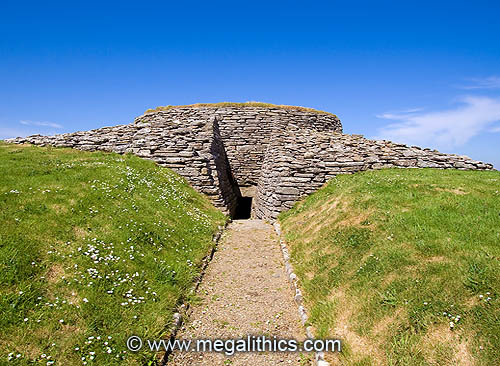
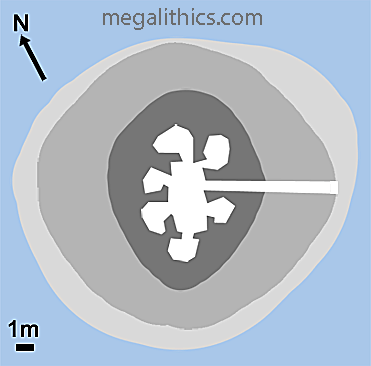
 |
 |
|
More Photos |
|
|
VR Tour |
||
|
|
Spin-o-rama |
||
|
|
3D Vision |
||
|
|
Infrared |
| HY 67660 37789, roof light, (GPS 62min) | Cairn (secondary casing) 20.5 x 17m (Pub.) |
| Visited June 2008 | Alt. 12m OD (roof light) |
Quoyness (ORK 44) is a well restored Maes Howe type chambered cairn on Sanday, one of the northern islands of Orkney. The cairn is situated on Els Ness, a peninsular on the south of the island reached by a very narrow isthmus. The site is presently very close to the sea, the tidal zone being only metres away from the gate to the site, given rising sea levels, the sea may not have been so close when the cairn was built. As an illustration of the change in sea level, another cairn, Augmond's Howe, around 250m to the south of Quoyness is currently in the process of being destroyed by coastal erosion.
Quoyness is mentioned in the New Statistical Account of 1845 (1) but the entries for Elsness are confusing, a description of the "burgh or fort" known as Augmund's Howe would seem to fit with Quoyness, "situated close to the beach and has been surrounded to landward by a circle of upright stones". A further description "On the east side, where the land is low, there is a semicircular terrace, the outer edge of which is formed also by stones set upright." would seem to describe the platform around Quoyness. Confusingly the Account then goes on to mention that "there is another burgh, a little to the west of Augmund's Howe also built by the beach", and then describes that a nearby cultivation area "has given the name Quoyness to this building".
The first published excavation of Quoyness was by James Farrer in 1867 (2), although this was a short account, Petrie (3) also recorded details from this investigation. A re-excavation of the cairn by Childe (4) in the 1950's was much more detailed and meticulous, most modern accounts of the site are based on this work. Childe attempts to clarify the naming confusion mentioned above by reporting that the monument is "erroneously called the Broch of Quoyness by the transfer of its proper name, Augmond's (Egmond's) Howe to the adjacent fortified site" and then proceeds to show a plan labelled "Quoyness chambered cairn" which has the figure title of "Egmond's Howe" !
After Childe's excavations in the 50's the cairn was "restored" and took on the rather strange appearance it bears to this day. The current state of the cairn reflects one school of thought on its original appearance and also, especially in the entrance and outer passage area, is presumably intended to reveal internal structures that would normally have been concealed from view when it was intact.
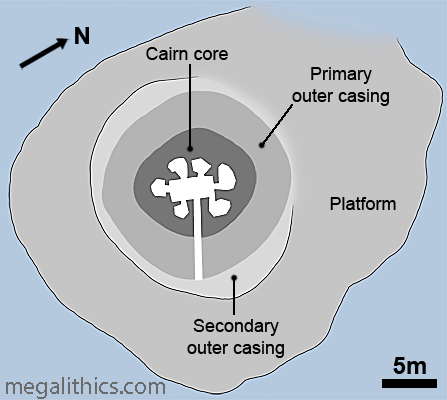
The cairn was found to have a complex structure, knowledge of this is based on findings from only four trenches by Childe, some of which did not extend down to ground level, so a degree of extrapolation has been used to generate the overall structural plan. In addition to limited examination of the internal structure, the outer sections of the monument suffered extensive damage prior to 1932, (particularly on the NW side) caused by stone robbing and the construction of a cart track.
The heart of the cairn is the cairn core, this is a rough oval 11m x 9m which is faced with a well constructed outer wall. This wall has an inward curve or batter to it, this feature becoming more pronounced towards the top. The tallest element of the cairn, Childe discovered 58 courses of slabs facing the core above the ground at the SSW. The cairn core houses all of the chamber elements and approximately half of the original passage length.
Surrounding the core is a layer known as the primary outer casing, this feature roughly mimics the shape of the core and it too is bounded by a well built wall. The primary casing is between 3.2m - 3.8m thick and together with its facing wall extends the diameter of the building to between 16.8m - 17.7m. Sections of the casing survive up to 2.7m high and it is likely that it was originally flush with the top of the cairn core. It is thought that most Orkney cairns were built to a height that only just covered the chamber roofstones, the intact cairn top at Vinquoy Hill has this arrangement, and the traces of capping that remain at Wideford Hill and Cuween Hill are consistent with this idea. It is likely that Quoyness had similar construction, the core and primary casing walls would have stopped just below the level of the chamber roofstones, a domed capping of overlapping stepped slabs would have covered the top of the cairn, presumably arranged to minimise rainwater penetration.
As can be seen in the plan diagram above, the passage ends at the facing of the primary casing. During the restorations of the 1950's two voids were left in the secondary casing either side of the passage entrance and these are the only areas where the facing wall of the primary casing can be viewed today. The primary casing (like the cairn core itself) was built upon the clay of the old ground surface, the casing is made up of very large blocks of stone on the lower levels near the cairn core, beyond and above these it is comprised of large slabs laid flat.
Surrounding the primary casing is the secondary casing, this is a thinner layer than the primary and does not follow its shape, causing a great variation in the thickness of this layer, Childe's plan shows a range of 0.9m -2.7m. As with the other two elements, this casing was faced with walling, and sections of this wall have been found standing at 1.2m high, these sections were found to be capped with what looked like coping stones and this is thought to have been the original height of the wall. Unlike the the core and primary casing, the secondary is not built on the ground surface, but instead upon the platform. As the platform was built against the outer wall of the primary casing it follows that both the platform and secondary casing are later additions to the structure. It is probable that the both the outer wall and the secondary casing itself were built across the entrance to the passage, Petrie notes " the outermost wall-face seems to have been built across the door of the passage". Childe found a ragged gap here through the outer casing, its walling, and the platform itself, this was almost certainly made by Farrer during his investigations. It seems likely that the construction of the platform and secondary casing marked the end of access to the cairn interior, indeed modern access to the passage is via a flight of steps down through the depth of the platform.
The platform which surrounds the core and casings covers an area greater than all of the other components combined, it has an irregular shape which does not follow that of any other element and measures approximately 41 x 32m. The platform is made up of three layers, the lowest is of stone slabs laid flat, above this is a mixture of earth, stones and midden material, the upper layer is of stones. Only the lower two layers extend under the outer casing, the upper layer of stones stops at the wall face. The outer circumference of the platform consists of a boulder bank against which slabs have been sloped on the outward side, into this slope slabs have been edge-set to form kerbstones. Childe's plan shows kerbs surviving over most of the south and west sides of the platform, presumably they once completely encircled it, during our visit we could find only a short run of perhaps five kerbs exposed at the SW. The platform may originally have had horns, traces of a wall projects out from the SW for about 5m and fainter traces of a similar structure were found at the north.
There seems to be two schools of thought
concerning the original appearance of the Orkney cairns
after all construction was finished. One idea is that the facing walls of the
outer cairn casings were left exposed and would have given the cairn an abrupt
vertical or stepped profile, the restoration at Quoyness follows this notion, as
does Kilbride-Jones' restoration of Wideford Hill (5). The second option
is for the cairn casings to have been buried inside a rounded mound, this view
is supported by Childe who considered Quoyness to have been "a domical cairn of stones, resembling in profile Maes
Howe", similarly, Renfrew (6) investigating Quanterness thought that the
cairn would have had "a rounded profile" in its finished form.
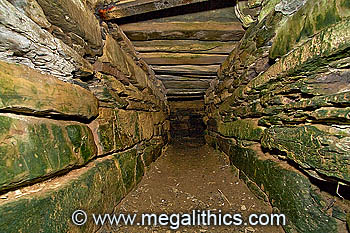 The passage runs for 7.35m NE through the cairn and opens in the
middle of the SW chamber wall, it narrows from 0.65m wide at the entrance
down to 0.55m as it enters the cairn core.
The passage runs for 7.35m NE through the cairn and opens in the
middle of the SW chamber wall, it narrows from 0.65m wide at the entrance
down to 0.55m as it enters the cairn core.
The outer section of the passage runs for 3.7m through the primary outer casing, Farrer describes finding this section roofed with edge set lintels during his investigations, but these had vanished by the time of Childe's excavtions in 1951-2 and this area remains unroofed today. At the entrance the passage walls were bonded into the facing wall of the primary casing, Childe also reported that the stones at the northern corner of the opening had been artificially rounded, but this may have due to wear, also the stones of the southern edge were destroyed during Farrer's investigations and could not be compared. The corner has been left exposed by a void made in the outer casing during restoration, so these rounded corner stones are visible today. The outer passage section was found to be floored with five stone slabs, these were simply laid and did not run under the sidewalls.
The inner passage section runs for 3.65m through the cairn core, it is 0.55m wide and is roofed at 0.8m. The roofing is of edge set lintels until immediately before the chamber where two flat laid stones were used. A second course of edge set lintels runs above the first and can be glimpsed through gaps in the first layer. Externally one of the lintels is visible sitting flush with the exposed walling of the cairn core, but there is no vertical seam through the passage walls as it passes below this and through the casing wall. In contrast to the outer passage section, this part had no stone flooring, natural clay being exposed throughout the length.
Farrer found the outer passage completely
blocked with stones and soil and the inner partially so, it is unknown if this
was a result of formal sealing of the cairn. As mentioned above, it is likely that access to
the cairn interior ceased with the building of the secondary outer casing and
the platform, as either of these additions would have blocked the passage
entrance.
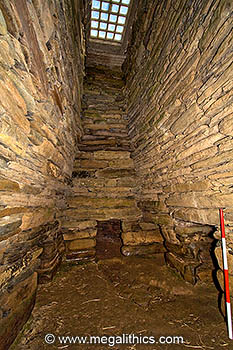 The main chamber is roughly rectangular and measures 1.8 x 4.0m
at floor level, this is gradually reduced by the corbelling of the walls and at
roof level the chamber measures only 0.9 x 3.3m. The walls are 4m high and are
vertical or slightly concave for the first metre, corbelling then begins and
continues until 1.5m below roof level when the walls once again become almost
vertical. The side and end walls are bonded at the corners and at 1-1.5m above
floor level each corner shows an unusual "oblique" slab that has been set across
the corner at roughly 45 degrees. There is some disagreement regarding the original
roofing arrangement, Farrer does not describe any intact roofing but Childe's
plan shows four roof slabs in place at the southern end, and indeed, there are
four slabs in this location at present.
The main chamber is roughly rectangular and measures 1.8 x 4.0m
at floor level, this is gradually reduced by the corbelling of the walls and at
roof level the chamber measures only 0.9 x 3.3m. The walls are 4m high and are
vertical or slightly concave for the first metre, corbelling then begins and
continues until 1.5m below roof level when the walls once again become almost
vertical. The side and end walls are bonded at the corners and at 1-1.5m above
floor level each corner shows an unusual "oblique" slab that has been set across
the corner at roughly 45 degrees. There is some disagreement regarding the original
roofing arrangement, Farrer does not describe any intact roofing but Childe's
plan shows four roof slabs in place at the southern end, and indeed, there are
four slabs in this location at present.
The floor of the main chamber is the natural clay upon which the chamber walls have been built. In the SE corner is a stone-lined pit approx. 0.8m in diameter and 0.2m deep, when found by Farrer it had a stone lid. A curious trench-like feature 0.5m wide and 0.2m deep runs from the passage opening across the chamber floor to the entrance of the northern side chamber.
There are six side chambers or cells arranged symmetrically with two in each of the long walls and one in each of the short. The entrances of the cells are between 0.45 - 0.63m wide and 0.6 - 0.7m high, each opening is capped with large lintel stones, most are double, the two above the northern opening spanning the entire width of the chamber. The overall height of the opening and lintel stone is around 1m, which corresponds to the height at which the walls begin to corbel in. The entrance to the NE cell is unusual in that it is positioned in the corner of the chamber, the north chamber wall being used as one side of the opening.
The cells are irregular in plan with maximum floor level dimensions of 1.3 - 2m, the walls corbel in abruptly above the level of entrance lintels in a circular manner and cell roof heights are between 1.4 - 2.0m. All of the cells have the same clay flooring as the main chamber except for the N and SW cells where the bedrock rises to floor level in places.
There are photos of the entrance, walling, and roof of each cell in our "More Photos" section, but in such small spaces as these only our VR panoramic tour allows every inch of the cairn interior spaces to be viewed.
The rock art section is under construction.
Artefact finds inside the cairn were sparse, definite finds in the chamber were a few small pottery sherds and two worked sandstone discs, one ground, and one roughly chipped. A polished bone pin and a three-pointed ground slate object were found either in the chamber or a side chamber, a second ground slate object was definitely found in a side chamber.
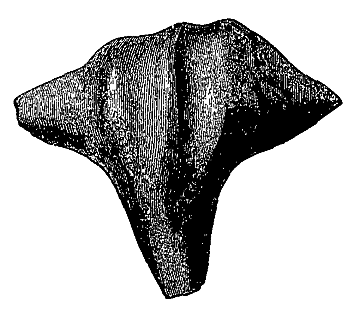 |
 |
|
| The three-pointed slate object (6 inches wide) and the polished bone pin (7 inches) found by Farrer. From (2) | ||
A large amount of decayed bone (0.4m deep) was found in the outer section of the passage, including several skulls. Farrer found skulls and human bones in the N, NE and SE cells and bone only in the NW cell, the circular floor pit yielded blackened leg and arm bones. Farrer sent the skulls to Dr. James Thurnam, the other bone was dumped in the chamber, Thurnam, a craniologist of the time, identified the remains of 12 to 15 people of both sexes and all ages. Childe had the bone he recovered examined by L.H.Wells at Edinburgh University who identified them as being from 10 adults of both sexes, 2 to 3 children over ten years of age and probably two under seven years, a satisfying agreement with Thurnam's earlier skull-based estimate.
Although being more difficult to reach than the main island cairns, we thought that Quoyness was something special and any megalithically inclined visitor should put a visit near the top of their list. There is a roof window that lets light into the main chamber and a torch is thoughtfully provided in a box mounted above the outer passage section, this will be useful for exploring the side chambers as these are very dark. Note that the interior can be a little muddy, so wear appropriate clothing.
Access-wise there is a long walk over rough ground from the nearest parking, and the 0.8m high entrance passage means a hands-and-knees crawl. Not suitable for disabled or infirm folk who will have to make do with our VR tour.
We noticed recently dated graffiti carved into the chamber walls, infuriatingly, we found that one area of rare prehistoric rock art has been destroyed by this in the last few years. Considering the remoteness of the cairn, we find it incomprehensible that anyone with the determination required to pay a visit would willingly damage it.
These special places have survived
thousands of years to reach us, please allow them passage through our time
without damage.
1.
New Statisical Account of Scotland, 15, p.137,
1845.
2. Farrer J.,
Proceedings of the Society of Antiquaries of Scotland,
7, p.398-401, 1868.
3. Petrie G., Notebook 9 (held at
National Museum of Antiquities of Scotland), p104-21.
4. Childe G. V.,
Proceedings of the Society of Antiquaries of Scotland,
86, p.121-39, 1952.
5. Kilbride-Jones H.E. Acta Prehistorica et
Archaeologica, 4, p75-96, 1973
6. Renfrew A.C. Society of Antiquaries of
London, Research Communication No.38, p44-180, 1979.